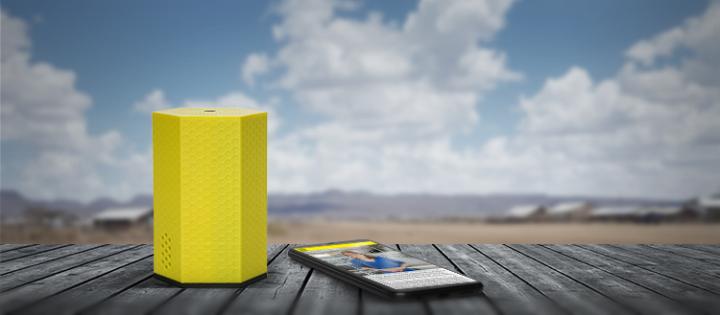Researchers at UNIGE have designed a box that allows users to log on to a learning platform without an internet connection or electricity supply

Credit: UNIGE
How can you send documents, watch educational videos or work collaboratively in regions where there is no internet coverage or electricity? These were the challenging questions taken up by researchers at the University of Geneva (UNIGE), Switzerland, who have developed a standalone box, known as the Beekee Box, that can generate a wireless network so users can log onto a learning platform without needing the internet or electricity supply. Anyone can connect to the Beekee Box’s wireless network via a smartphone, computer or tablet, accessing educational content, chatting with other users or taking part in assessments. The box means that trainers can take their teaching materials with them when they’re overseas in refugee camps or war zones, using it as a teaching platform with learners in situ.
Digital tools are employed on a massive scale in education to enhance teaching methods, but often require an internet connection – which is why researchers in learning and teaching technologies (TECFA) in UNIGE’s Faculty of Psychology and Educational Sciences (FPSE) developed the Beekee Box. This standalone device generates a local wireless network that anyone can connect to and access information hosted on the platform. “It’s as though users were browsing the educational platform on the web but without the need for the internet or power grid”, says Vincent Widmer, a TECFA researcher and the man behind the Beekee Box. “Anyone who is logged on can follow entire training programmes, carry out assessments, access documents or interact with their peers in real time.”
A secure environment controlled by the teacher
The box is simple to use: teachers import all the educational material they need onto the Beekee Box from their computer, then take the box with them all over the world. Users only need to connect their mobile devices to the local network generated by Beekee Box to access and stream content. “Teachers can restrict their interactions with students just to the box network, without the data being shared over the internet. Everything remains confidential and compartmentalised on the Beekee Box, which is a huge asset in terms of protecting personal data!” explains Stéphane Morand, a system engineer at TECFA.
A big plus for humanitarian workers
Internet access can be seriously disrupted in war zones or refugee camps. The Beekee Box circumvents this problem since it enables learners to access educational content and comprehensive training programmes. A trial is currently underway in the Kakuma refugee camp in Kenya as part of a collaboration with UNIGE’s InZone project, which develops and approves innovative solutions to help refugees follow university courses and obtain ECTS credits. “InZone has set up a training room in Kakuma with 12 computers, while the camp is home to around 190,000 people,” says Sergio Estupiñan, a TECFA researcher who visited Kenya in February 2019. “What’s more, the camp is huge and getting about is difficult, even dangerous. Most of the refugees have a smartphone, meaning they could use the Beekee Box to take courses in different parts of the camp.”
But the Beekee Box is not limited to refugee camps: it can be used in other contexts, such as for providing assistance in crisis situations, as during the Ebola epidemic in Congo. “We are currently working with Médecins Sans Frontières to help doctors provide crisis management training and to send recent medical guides,” says Vincent, before adding: “Our goal is to make our educational, technological and research skills available to analyse the context and provide tailor-made solutions.”
The Beekee Box’s casing is made of durable, recyclable plastic, and the unit consists of a microcomputer and battery module. It is 10 cm high and 6.5 cm wide, and can hold up to 256 GB of data with a battery life of around 3 hours – or over 10 hours with an external battery, which can be recharged using solar energy. “It takes about 9 hours to print the box with our 3D printers and 20 minutes to put it together,” says Julien Venni, another TECFA researcher. “If you include the programming – which is customised to meet the needs of users – a Beekee Box is ready in about 10 hours for a material cost at present of about 150 Swiss francs.” The team is developing its own software which is also based on open-source technologies, such as the MoodleBox project by Nicolas Martignoni from Friborg, which they modify to suit their requirements. Everyone can build their box and programme it or use the services of the Beekee Box team.
###
Media Contact
Vincent Widmer
[email protected]



